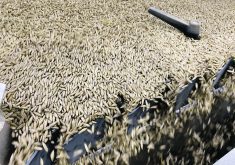Domestic demand from new crushing plant is expected to limit the amount of Canadian crop available for export
Some of Canada’s traditional canola customers are going to be out of luck starting in 2024, according to a major farm lender.
That is when new domestic crush capacity is supposed to come online.
Expansions and new builds by Richardson International, Viterra and Cargill will add 4.6 million tonnes of capacity next year.
Federated Co-operatives Limited/AGT Food and Ingredients, Bunge and Louis Dreyfus will add another 3.2 million tonnes of capacity at an unspecified date.
That is 7.8 million tonnes more canola needed for domestic use that will no longer go to overseas markets.
Read Also

Prairies have variable soil moisture conditions
The dry weather in the west was welcome for preserving grain quality and advancing harvest, but it has resulted in very dry soil moisture conditions.
To put that in perspective, Canada is forecast to export 8.8 million tonnes of the oilseed in 2023-24.
However, the full 7.8 million tonnes of new capacity will not be immediately available. It will take time to ramp up operations at these new plants.
But there will be a huge new source of domestic demand for the crop and that has consequences for overseas buyers.
“There will be some decline in exports,” said Justin Shepherd, senior economist with Farm Credit Canada.
He added there will be a chance to increase meal and oil exports, although much of the oil will be diverted to biofuel markets in North America.
Shepherd would not speculate on which export markets are going to lose out because it is difficult to predict future global trade patterns.
But there will likely be at least a temporary curtailment of canola crush in some of those markets.
China, Japan and Mexico typically account for 80 percent of Canada’s canola seed exports, while the United States usurps 78 percent of its canola oil shipments.
Shepherd said some seed markets may have to switch to buying oil and meal. The U.S. and China buy almost all of Canada’s canola meal exports.
The Canola Council of Canada has long been promoting the idea that production can be ramped up to meet both domestic and export demand for the crop.
But the statistics don’t back that up.
In 2014, the council established a national average yield target of 52 bushels per acre by 2025. Last year’s average was 37.7 bu., and the previous five-year average is 38.6.
Shepherd said yields have been growing at a clip of about six-tenths of a bushel per year over the past three decades, which is not enough additional canola to fully supply both markets.
Meanwhile, acreage has been around 20 to 23 million acres since 2012. Industry executives have expressed a desire to expand acreage in the brown soil zone of the Prairies, but that will take time.
Shepherd expected crushers will attempt to expand acreage through aggressive pricing in 2024, so they can have enough product to feed their new plants.
He wonders if that might prompt growers to plant another couple million acres of canola in the next two to three years, although he acknowledged that will be a challenge while maintaining rotations.
“It is going to be interesting to see if bids are actually able to push up acreage,” he said.
Shepherd said the growing domestic demand for the crop combined with the constrained supply makes him bullish for canola in 2024 and the years to follow.
“Especially for local producers who are nearby crush plants, there should be some opportunities there for improved basis levels,” he said.
There should also be upward pressure on futures prices, since Canada is the global driver of canola markets.
Canola futures are also strongly tied to soybean oil and other vegetable oil markets. There is good news on that front as well because of the wave of soybean crush expansion happening in the U.S. to meet demand from the exploding renewable diesel sector.
“There’s some very strong global supply and demand reasons why canola should be supported going forward,” he said.
















